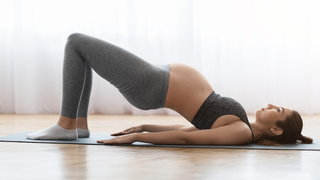In this article:
Exercising in pregnancy is not about performance. It’s about keeping your muscles strong enough to support your posture, easing back pain, boosting energy, and preparing for delivery and recovery. The goal is to move, not to overdo.
Prenatal Yoga: Finding Balance and Calm
Prenatal yoga is one of the most popular and adaptable forms of exercise during pregnancy. It combines gentle stretching, breathing, and mindfulness, helping both your body and mind adjust to the ongoing changes.Benefits:
- Improves flexibility and posture: Yoga helps open the hips and strengthen your spine, reducing back pain and stiffness.
- Supports mental well-being: B`reathing and mindfulness reduce anxiety and promote better sleep.
- Enhances circulation: Gentle stretching helps reduce swelling in your hands and feet.
- Prepares you for labour: Controlled breathing techniques can be used during contractions to manage pain and maintain calm.
Pilates: Strengthening Your Core and Stability
Pilates focuses on controlled movements that strengthen your core, pelvic floor, and back muscles, areas most affected during pregnancy. When taught by a certified prenatal instructor, Pilates can help maintain stability and prevent injury as your centre of gravity shifts.Benefits:
- Protects the lower back: Core activation supports your spine as your belly grows.
- Improves balance: Gentle stability work helps prevent falls and eases movement in daily life.
- Enhances pelvic floor strength: Strong pelvic muscles reduce urinary leakage and aid postpartum recovery.
If you have diastasis recti (separation of abdominal muscles), your instructor can help modify exercises to protect your midline.
Swimming and Water Workouts: Relief in Motion
Water-based exercise is one of the safest and most soothing ways to stay active in pregnancy. The buoyancy of water supports your growing body and relieves joint pressure, while the cool environment helps regulate temperature.Benefits:
- Reduces swelling: Water pressure aids lymphatic flow and decreases ankle or leg puffiness.
- Eases back and hip pain: The weightless feeling allows freer movement without strain.
- Improves heart and lung function: Swimming engages large muscle groups for gentle cardiovascular fitness.
- Boosts mood: Water movement releases endorphins and reduces fatigue.
- Avoid hot pools, jacuzzis, or saunas as overheating can raise core body temperature.
- Stay hydrated and avoid overexertion.
- Choose pools with good hygiene standards to reduce infection risk.
- Backstroke, side stroke, and gentle aqua aerobics are generally safe; avoid diving or sudden twists.
Walking: The Simplest, Safest, and Most Accessible Exercise
Walking remains one of the easiest ways to stay active during pregnancy. It doesn’t require equipment, training, or gym access; just a comfortable pair of shoes and regular habit.Benefits:
- Improves cardiovascular health: Keeps your heart and lungs fit without stressing your joints.
- Reduces gestational diabetes risk: Regular brisk walking helps stabilise blood sugar.
- Boosts circulation: Helps prevent leg cramps and swelling.
- Supports emotional balance: A walk outdoors releases serotonin and provides mental clarity.
For many expecting mothers, walking also doubles as mindfulness, a simple ritual that connects you to your changing body and your baby’s rhythm.
Strength Training: Building Support for a Growing Body
Pregnancy often feels like carrying extra weight, because you are. Strength training, when done safely, prepares your muscles to handle it better. It also supports joints that become more mobile due to the hormone relaxin.Benefits:
- Reduces back and pelvic pain: Strong glutes and core muscles stabilise the spine.
- Improves posture: Prevents slouching caused by the forward-shifted centre of gravity.
- Builds stamina for labour: Labour is physically demanding; strength training prepares you for endurance.
- Aids recovery: Maintaining muscle tone helps your body bounce back post-delivery.
- Use lighter weights and increase repetitions instead of heavy loads.
- Focus on controlled breathing. Exhale when lifting, inhale when lowering.
- Avoid jerky movements or exercises that strain the abdomen.
- Skip lying flat or heavy overhead lifts in the second and third trimesters.
- Include squats, seated rows, resistance band pulls, and wall push-ups.
- First Trimester: Continue light strength training if you were already active; focus on form and hydration.
- Second Trimester: Shift to seated or supported exercises; reduce balance-dependent movements.
- Third Trimester: Prioritise mobility and stability. Gentle squats and stretches are better than resistance work.
When to Stop and Seek Medical Advice
Even with a low-risk pregnancy, certain symptoms mean you should stop exercising and speak with your doctor immediately:- Vaginal bleeding or spotting
- Sudden shortness of breath before exertion
- Dizziness, chest pain, or severe headache
- Calf pain or swelling
- Amniotic fluid leakage
- Regular painful contractions
- Decreased fetal movements
Movement during pregnancy is a conversation between you and your body. Yoga helps you breathe through discomfort, Pilates builds stability, swimming eases pressure, walking grounds your energy, and strength training prepares you for the weight you carry, both physically and emotionally. Exercise doesn’t need to be perfect. It only needs to be consistent, mindful, and kind. With the right balance of caution and care, staying active can help your pregnancy feel lighter, stronger, and more in tune with yourself.
Whether you’re pregnant, a new mom, or navigating postpartum, you don’t have to do it alone. Join our support group to connect, share, and support one another.
FAQs on Types of Pregnancy Exercises: From Prenatal Yoga to Strength Training
- Is it safe to start exercising if I wasn’t active before pregnancy?
Yes, start slow. Begin with light walks or prenatal yoga under supervision. Avoid sudden, high-intensity workouts and consult your doctor before beginning any new routine - Which trimester is best for yoga or swimming?
You can practise yoga or swim throughout pregnancy, provided your doctor clears it. The second trimester is usually the most comfortable as nausea decreases and energy returns. - Can exercise cause miscarriage or preterm labour?
Moderate exercise in healthy pregnancies does not cause miscarriage. In fact, studies show it lowers the risk of gestational diabetes and preeclampsia. Always stop if you notice pain or bleeding. - How can I stay motivated when I feel tired or nauseous?
Choose gentle forms like walking, stretching, or breathing exercises. Focus on how movement makes you feel rather than treating it as a task.









